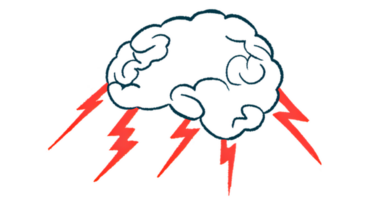Newly ID’d brain ‘noise’ can track Parkinson’s symptom severity
Discovery of irregular electrical signal may help improve DBS treatment

Researchers have uncovered a previously overlooked type of electrical brain activity — an irregular signal they call noise — that closely tracks the severity of motor symptoms in people with Parkinson’s disease.
The discovery, made by scientists at the Max Planck Institute in Germany, in collaboration with research teams from two other German universities and two in the U.K., offers new insights into how Parkinson’s alters brain signaling. The findings illustrate that disease “features beyond conventional [ones]” are “critical to understanding” the physiological processes of Parkinson’s, according to the team.
Focusing on so-called brain noise may help refine deep brain stimulation (DBS), a treatment that uses mild electrical pulses to modulate abnormal brain activity and ease Parkinson’s symptoms, the team noted.
Their study, “Beyond beta rhythms: subthalamic aperiodic broadband power scales with Parkinson’s disease severity – a cross-sectional multicentre study,” was published in the journal eBioMedicine. The Max Planck team worked with researchers at the Charité-Universitätsmedizin Berlin and Heinrich Heine University Düsseldorf, both in Germany, and University College London and the University of Oxford in the U.K.
Parkinson’s disease is caused by the gradual loss of dopamine-producing nerve cells in the brain, which play a key role in controlling movement. This loss disrupts the brain’s normal circuitry, causing some nerve cells to fire excessively and others to fire too little, leading to the motor symptoms that are a hallmark of Parkinson’s.
DBS is a surgical treatment that involves implanting electrodes into specific brain regions, with the aim of normalizing electrical activity by delivering mild electrical pulses. In addition to easing symptoms, DBS allows scientists to record electrical brain activity directly from deep structures that are otherwise inaccessible in living humans.
Looking beyond what’s known in the human brain
For years, scientists have focused on rhythmic brain waves, or repeated electrical patterns that occur when groups of nerve cells fire together in a coordinated way. In Parkinson’s disease, one type of these electrical patterns, known as beta waves, becomes unusually strong and has been linked to the severity of motor symptoms.
Yet, across studies, the strength of these signals has not always matched patients’ symptom severity.
“We wondered why earlier studies from different centers had produced such mixed results,” Vadim Nikulin, PhD, principal investigator at the Max Planck Institute, said in a press release detailing the team’s discovery.
According to Nikulin, that led the team to ask: “Did the patient groups differ, the recording equipment, or the analysis methods?”
In search of an explanation, the researchers pooled and analyzed brain recordings from 119 people with Parkinson’s who had undergone DBS surgery at five leading European university hospitals. These patients had a mean age of 63, and a mean disease duration of almost 10 years. Motor tests showed moderate to severe impairment.
When the scientists examined the rhythmic beta waves, they found that stronger beta activity was indeed linked to more severe motor symptoms, but the link was weaker than expected. It only became clear when data from all 119 patients were analyzed together, the team found. That explained why smaller studies had often shown conflicting results, according to the researchers.
Team investigated brain activity often dismissed as ‘noise’
The team then looked beyond these rhythmic waves, analyzing the brain’s background electrical activity — signals often dismissed as “noise.” Unlike the neatly repeated beta patterns, this noise does not follow a rhythm; instead, it reflects more irregular and uncoordinated firing of different nerve cells, the researchers noted.
By separating the rhythmic from the nonrhythmic components, the researchers found that this irregular, noise-like signal tracked patients’ motor symptoms much more closely than beta waves. In earlier research, both signals had been lumped together, masking the distinct role of this “noise.”
“You can imagine the brain as a concert hall full of musicians before a rehearsal,” said Moritz Gerster, a doctoral student at the Max Planck Institute who led the study. “Some groups play together, creating a distinct rhythm. Others practice on their own, merging into a nonrhythmic ‘noise.’ If you only measure the overall volume, you miss this distinction.”
Because Parkinson’s affects each person differently and DBS is used only in advanced disease, the study had no healthy control group. Instead, the team leveraged a hallmark feature of Parkinson’s — its asymmetry, where one side of the body is more affected than the other.
“That gave us the idea to compare the more‑affected hemisphere [or half side of the brain] with the less‑affected one,” Gerster said. “This way, each patient could practically serve as their own control.”
You can imagine the brain as a concert hall full of musicians before a rehearsal. … Some groups play together, creating a distinct rhythm. Others practice on their own, merging into a nonrhythmic ‘noise.’ If you only measure the overall volume, you miss this distinction.
The analysis showed that the brain hemisphere controlling the more affected side showed much higher levels of this irregular, noise-like activity, suggesting an increased firing rate of nerve cells and supporting the idea that the strength of this noise signal correlates with the severity of motor symptoms.
The team said this nonrhythmic signal could serve as a within-patient biomarker — a kind of personal electrical fingerprint that tracks symptom severity over time.
This newly identified electrical signature also may help make DBS more precise, according to the team. Instead of delivering continuous stimulation, already available adaptive electrodes could monitor brain activity in real time and apply stimulation only when needed, the researchers said.








